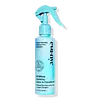What's inside
What's inside
 Key Ingredients
Key Ingredients

No key ingredients
 Benefits
Benefits

 Concerns
Concerns

 Ingredients Side-by-side
Ingredients Side-by-side

Water
Skin ConditioningCetrimonium Chloride
AntimicrobialAmodimethicone
Acrylates/Dimethylaminoethyl Methacrylate Copolymer
Hydrolyzed Silk
HumectantBenzophenone-4
UV AbsorberGlucose
HumectantRosmarinus Officinalis Leaf Extract
AntimicrobialSalvia Officinalis Leaf Extract
CleansingChamomilla Recutita Flower Extract
MaskingUrtica Dioica Extract
AstringentMelissa Officinalis Leaf Extract
Skin ConditioningTussilago Farfara Flower Extract
AstringentEquisetum Arvense Extract
AstringentAesculus Hippocastanum Seed Extract
Skin ConditioningTrideceth-12
EmulsifyingOctoxynol-13
EmulsifyingMethylparaben
PreservativeImidazolidinyl Urea
PreservativePropylparaben
PreservativeCitric Acid
BufferingPropylene Glycol
HumectantEthoxydiglycol
HumectantParfum
MaskingWater, Cetrimonium Chloride, Amodimethicone, Acrylates/Dimethylaminoethyl Methacrylate Copolymer, Hydrolyzed Silk, Benzophenone-4, Glucose, Rosmarinus Officinalis Leaf Extract, Salvia Officinalis Leaf Extract, Chamomilla Recutita Flower Extract, Urtica Dioica Extract, Melissa Officinalis Leaf Extract, Tussilago Farfara Flower Extract, Equisetum Arvense Extract, Aesculus Hippocastanum Seed Extract, Trideceth-12, Octoxynol-13, Methylparaben, Imidazolidinyl Urea, Propylparaben, Citric Acid, Propylene Glycol, Ethoxydiglycol, Parfum
Water
Skin ConditioningGlycerin
HumectantCetearyl Alcohol
EmollientButylene Glycol
HumectantBehentrimonium Chloride
PreservativeSodium Hyaluronate
HumectantSh-Polypeptide-121
Skin ConditioningOryza Sativa Extract
AbsorbentAlthaea Officinalis Root Extract
Skin ConditioningOlea Europaea Fruit Oil
MaskingPrunus Amygdalus Dulcis Oil
Skin ConditioningSesamum Indicum Seed Oil
EmollientGuar Hydroxypropyltrimonium Chloride
Skin ConditioningQuaternium-80
Tetrasodium Glutamate Diacetate
Lauryl Laurate
Skin ConditioningPanthenol
Skin ConditioningGlycereth-17 Cocoate
EmulsifyingPotassium Sorbate
PreservativeSodium Benzoate
MaskingBenzoic Acid
Masking1,2-Hexanediol
Skin ConditioningEthylhexylglycerin
Skin ConditioningPhenoxyethanol
PreservativeParfum
MaskingWater, Glycerin, Cetearyl Alcohol, Butylene Glycol, Behentrimonium Chloride, Sodium Hyaluronate, Sh-Polypeptide-121, Oryza Sativa Extract, Althaea Officinalis Root Extract, Olea Europaea Fruit Oil, Prunus Amygdalus Dulcis Oil, Sesamum Indicum Seed Oil, Guar Hydroxypropyltrimonium Chloride, Quaternium-80, Tetrasodium Glutamate Diacetate, Lauryl Laurate, Panthenol, Glycereth-17 Cocoate, Potassium Sorbate, Sodium Benzoate, Benzoic Acid, 1,2-Hexanediol, Ethylhexylglycerin, Phenoxyethanol, Parfum
Ingredients Explained
These ingredients are found in both products.
Ingredients higher up in an ingredient list are typically present in a larger amount.
Parfum is a catch-all term for an ingredient or more that is used to give a scent to products.
Also called "fragrance", this ingredient can be a blend of hundreds of chemicals or plant oils. This means every product with "fragrance" or "parfum" in the ingredients list is a different mixture.
For instance, Habanolide is a proprietary trade name for a specific aroma chemical. When used as a fragrance ingredient in cosmetics, most aroma chemicals fall under the broad labeling category of “FRAGRANCE” or “PARFUM” according to EU and US regulations.
The term 'parfum' or 'fragrance' is not regulated in many countries. In many cases, it is up to the brand to define this term.
For instance, many brands choose to label themselves as "fragrance-free" because they are not using synthetic fragrances. However, their products may still contain ingredients such as essential oils that are considered a fragrance by INCI standards.
One example is Calendula flower extract. Calendula is an essential oil that still imparts a scent or 'fragrance'.
Depending on the blend, the ingredients in the mixture can cause allergies and sensitivities on the skin. Some ingredients that are known EU allergens include linalool and citronellol.
Parfum can also be used to mask or cover an unpleasant scent.
The bottom line is: not all fragrances/parfum/ingredients are created equally. If you are worried about fragrances, we recommend taking a closer look at an ingredient. And of course, we always recommend speaking with a professional.
Learn more about ParfumWater. It's the most common cosmetic ingredient of all. You'll usually see it at the top of ingredient lists, meaning that it makes up the largest part of the product.
So why is it so popular? Water most often acts as a solvent - this means that it helps dissolve other ingredients into the formulation.
You'll also recognize water as that liquid we all need to stay alive. If you see this, drink a glass of water. Stay hydrated!
Learn more about Water